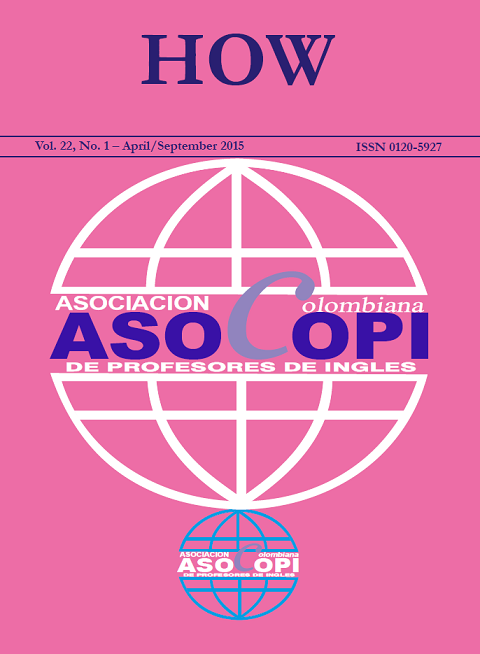Motivation in Second Language Learning: A Historical Overview and Its Relevance in a Public High School in Pasto, Colombia
Main Article Content
Abstract
Article Details

This work is licensed under a Creative Commons Attribution-NonCommercial-NoDerivatives 4.0 International License.
The authors of the manuscripts accepted for publication in HOW journal are required to sign a nonexclusive license agreement allowing ASOCOPI to reproduce the full text on the Internet or in any other available source. Authors retain copyright of their manuscripts with the following restrictions: first publication is granted to ASOCOPI; nonexclusive agreements with third parties can be established as long as the original publication in the HOW journal is properly acknowledged.
References
Burgos, D. C. (2011, January 30). Educación de Pasto: entre deserción y hacinamiento [Education in Pasto: Between dropping out and overcrowding]. Diario del Sur. Retrieved from http://www.mineducacion.gov.co/observatorio/1722/article-262918.html.
Dörnyei, Z. (1994). Motivation and motivating in the foreign language classroom. The Modern Language Journal, 78(3), 273-284. http://dx.doi.org/10.1111/j.1540-4781.1994.tb02042.x.
Dörnyei, Z. (2002). The motivational basis of language learning tasks. In P. Robinson (Ed.), Individual differences and instructed language learning (pp. 137-158). Philadelphia, PA: John Benjamins. http://dx.doi.org/10.1075/lllt.2.10dor.
Dörnyei, Z., & Ushioda, E. (Eds.). (2009). Motivation, language identity, and the L2 self. Bristol, UK: Multilingual Matters.
Dörnyei, Z., & Ushioda, E. (2011). Teaching and researching motivation. Harlow, UK: Pearson Education.
Escuela Normal de Pasto. (2014). Educación Básica Secundaria [High-School Education]. Retrieved from http://www.escuelanormalpasto.edu.co/index.php?option=com_content&view=article&id=38&Itemid=38.
Gardner, R. C. (1985). Social psychology and second language learning: The roles of attitudes and motivation. Baltimore, MD: Edward Arnold Publishers.
Gardner, R. C. (2010). Motivation and second language acquisition: The socio-educational model. New York, NY: Peter Lang Publishing.
Gardner, R. C., & Lambert, W. E. (1972). Attitudes and motivation in second-language learning. Boston, MA: Newbury House Publisher.
Hadfield, J., & Dörnyei, Z. (2013). Motivating learning: Research and resources in language teaching. Harlow, UK: Pearson.
Kiil Molberg, H. K. (2010). The consequence of motivation and linguistic self-confidence in relation to pupils’ oral interaction. University of Tromsø, Norway. http://munin.uit.no/bitstream/handle/10037/2951/thesis.pdf?sequence=1.
King, J. (2014). Second language learning. B6: Motivation [PowerPoint Presentation]. University of Leicester, United Kingdom.
MacIntyre, P. D. (2002) Motivation, anxiety, and emotion in second language acquisition. In P. Robinson (Ed.), Individual differences and instructed language learning (pp. 45-68). Philadelphia, PA: John Benjamins. http://dx.doi.org/10.1075/lllt.2.05mac.
Motivation. (n.d.). In Psychology Dictionary Online. Retrieved from http://psychologydictionary.org/letter/m/page/97/.
Motivation. (2014). In Oxford Online Dictionary. Retrieved from http://www.oxforddictionaries.com/definition/english/motivation?q=motivation.
O’Rourke, B. (2011). Galician and Irish in the European context: Attitudes towards weak and strong minority languages. Bristol, UK: Palgrave Macmillan.
Schumann, J. H. (1986). Research on the acculturation model for second language acquisition. Journal of Multicultural and Multilingual Development, 7(5), 379-392. http://dx.doi.org/10.1080/01434632.1986.9994254.
Ushioda, E. (2009). A person-in-context relational view of emergent motivation, self, and identity. In Z. Dörnyei & E. Ushioda (Eds.), Motivation, language identity, and the L2 self (pp. 215-228). Bristol, UK: Multilingual Matters.





